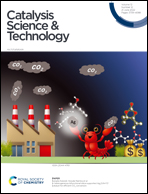Enhanced hydrothermal stability and SO2-tolerance of Cu–Fe modified AEI zeolite catalysts in NH3-SCR of NOx†
Abstract
The inferior low-temperature activities of Fe-SSZ-39 zeolites with AEI structure limit their broader applications in NH3-SCR. In this study, we improved the NH3-SCR reactivity of Fe-AEI zeolite by introducing Cu ions. By adjusting Cu/Al and Fe/Al molar ratios, the optimal Cu0.42/Fe0.16-AEI catalyst shows significantly enhanced NH3-SCR activity and hydrothermal stability over Fe- and Cu-AEI zeolites. Furthermore, the optimized Cu/Fe-AEI bimetallic catalyst exhibits the best NO conversion (70%) at 250 °C in triplicate SO2 poisoning (50 ppm) and regeneration tests. According to NH3-DRIFTS, XRD, and 27Al MAS NMR results, the introduction of Cu significantly increases the stability of the framework Al, thus improving the hydrothermal stability of the Cu/Fe bimetallic catalyst. H2-TPR, EPR, NO-DRIFTS and kinetics analyses demonstrate that more Z-CuOH+ species at 8MR are the most active centers for NH3-SCR, and are more stable in the Cu/Fe-AEI catalysts than in Cu-AEI. TGA, H2-TPR and kinetics results suggest that Fe ions may suppress the formation of ammonium sulfates, and may also act as the sacrificial component to protect Cu2+ active sites to some extent from sulfur deactivation. These contribute to the enhanced SO2-tolerance of Cu0.42/Fe0.16-AEI.



 Please wait while we load your content...
Please wait while we load your content...